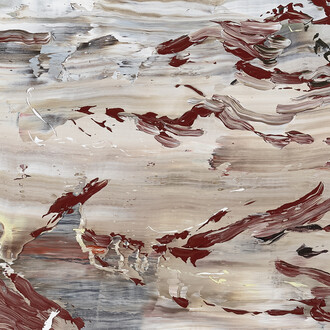Secci Gallery is pleased to announce Exercises in ruins, the first Italian solo exhibition of Lebanese artist Omar Mismar (1986), at its Via Olmetto venue in Milan. The exhibition marks the second appointment of the Novo Biennial project, a cycle of exhibitions curated by Marco Scotini and inaugurated last April with Doruntina Kastrati.
Following the international recognition gained with his extraordinary mosaics presented at the 60th Venice Biennale, Foreigners Everywhere, Omar Mismar now introduces a new series of works that unfold across different media and a wide array of themes—seemingly distant, yet all linked by a single denominator: the political nature of the relationship between desire and absence, where desire must be read as the impossibility of presence.
Emerging artistically from the debates on the relationship between politics and media that animated the social uprisings of the so-called Arab Spring, Mismar’s practice focuses on the production of images in relation to conflict and its representations. Over the past years, he has developed what he himself defines as an “aesthetics of disaster,” questioning the truthfulness of documentary imagery and offering an alternative to the hyperrealism of new visual devices. For Mismar, the ruins of disaster are not so much those of a visible explosion, but rather the result of absence, failure, and less perceptible ruptures.
The use of mosaic technique in Mismar’s work—replicating archaeological artifacts, refugee blankets, and press photographs found online—dates back to 2015, when the artist met Syria’s “Monuments Men,” a group of conservators at the Ma’arrat al-Numan Museum who voluntarily dedicated themselves to saving ancient mosaics threatened by Bashar al-Assad’s bombings. Among them was Abou Farid, an archaeological inspector and conservator, who shared part of his photographic archive with Mismar. From this exchange arose inspiration for mosaics that transform photographs into forms of cultural resistance, as well as the video Abou Farid’s War (2021), in which Mismar converses with Farid via videocall on conservation, destruction, and the circulation of images in times of war.
The archaic tesserae of mosaics are also comparable to single points of colour, like the thousands of pixels in a digital image. Mismar constantly reminds us that behind each of his works the sources and references are drawn from the everyday use of the web. Yet, through the temporal gap created by the translation into mosaics, the artist stages not only the contrast between the archaic nature of contemporary authoritarianism and the hypermodernity of new media, but also a relational distance inherent to contemporary technologies themselves.
In the final two rooms of the exhibition space, we encounter mosaics such as those in the series Torsos (2025), which depict fragments of nude male busts sourced from dating apps as if they were archaeological finds. Here we recognize the same experience of absence and desire. Just as when we stand before the red neon of the series The path of love (2013), which reduces to a luminous trace the path traveled by the artist to reach a nocturnal encounter in San Francisco with a stranger found via Grindr, the gay geolocation app.
Apps that crash, users who disappear offline, distances that prevent real contact. These attempts at closeness are often interrupted by digital accidents, creating a web of partial traces, interruptions, and unreachable desires. Disaster becomes the impossibility of relationship, the breakdown of communication, but also the irreducible desire for it to occur.
This framework sheds light on the first large room of Exercises in ruins, where three monumental mosaics refer to the ongoing tragedy in Gaza. The mosaic panels recount the story of Salman al- Nabahin and his son Ahmad in the Bureij refugee camp. While tending to his difficult olive cultivation, Salman discovered a Byzantine mosaic underground.
Olive in the sun features part of that original mosaic, with a shadow cast over it to recall the Israeli strategy of planting pines to erase the site’s historical memory, while preserving the image of the olive grove—now destroyed, as satellite images reveal. In Ahmad with the Sponge, Salman’s son Ahmad attempts to bring back the vivid colours of the mosaic. Finally, in Salman in a Squat, the owner of the olive grove crouches above the mosaic, appearing serene, like a suspended presence, while we remain unaware of his and his son’s fate under the bombings. All these images thus emerge as visible forms of absence.















